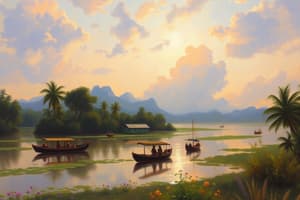Podcast
Questions and Answers
What does the term 'Filipino' primarily refer to?
What does the term 'Filipino' primarily refer to?
- An ancient form of Philippine literature
- A type of Filipino dance
- The traditional clothing of the Philippines
- The citizens of the Philippines and their culture (correct)
Which of the following is NOT one of the major ethnic groups in the Philippines?
Which of the following is NOT one of the major ethnic groups in the Philippines?
- Ayutthaya (correct)
- Ilocano
- Tagalog
- Cebuano
What is the national language of the Philippines?
What is the national language of the Philippines?
- Hiligaynon
- Filipino (correct)
- Cebuano
- Spanish
Which statement reflects a key aspect of Filipino culture?
Which statement reflects a key aspect of Filipino culture?
What percentage of the Philippine population is predominantly Roman Catholic?
What percentage of the Philippine population is predominantly Roman Catholic?
Which traditional dish is a characteristic of Filipino cuisine?
Which traditional dish is a characteristic of Filipino cuisine?
What is one significant theme reflected in Philippine literature?
What is one significant theme reflected in Philippine literature?
Which mythical creature is part of Philippine folklore?
Which mythical creature is part of Philippine folklore?
Flashcards are hidden until you start studying
Study Notes
Cultural Identity
- The term "Filipino" refers to the citizens of the Philippines and their culture.
- It encompasses a rich blend of indigenous, Spanish, American, and Asian influences.
Ethnic Groups
- The Philippines is home to approximately 175 ethnolinguistic groups.
- Major groups include Tagalog, Cebuano, Ilocano, Visayan, and Moro among others.
Language
- Filipino is the national language, based on Tagalog, and is one of the official languages along with English.
- The country has more than 175 languages, with regional variations.
Customs and Traditions
- Family plays a central role in Filipino culture, emphasizing strong family ties and community.
- Festivals, known as "fiestas," are celebrated nationwide, often linked to patron saints.
Religion
- Predominantly Roman Catholic (about 80% of the population), with a significant number of Muslims, particularly in the southern region (Bangsamoro).
- Other religions present include Protestantism and indigenous belief systems.
Cuisine
- Filipino cuisine is a fusion of various influences, characterized by dishes like adobo, sinigang, lechon, and lumpia.
- Rice is a staple, and meals often include a variety of side dishes.
Arts and Literature
- The Philippines has a vibrant arts scene, with traditional forms such as weaving, pottery, and dance.
- Literature often reflects social issues, culture, and history with notable authors like José Rizal, Nick Joaquín, and Lualhati Bautista.
Folklore and Mythology
- Rich in folklore, with tales of mythical creatures (e.g., aswang, kapre).
- Legends and epics often center on moral lessons and cultural values.
Modern Society
- The Filipino diaspora is significant, with millions living abroad, contributing to the global Filipino identity.
- Social issues include poverty, education, and political challenges, which shape contemporary Filipino life.
National Symbols
- Flag features a blue field (peace), red (bravery), and white triangle (equality).
- The national anthem is "Lupang Hinirang," symbolizing national pride.
Contributions
- Filipinos are known for their resilience, creativity, and adaptability, contributing to various fields like healthcare, arts, and technology both locally and internationally.
Cultural Identity
- The term "Filipino" encompasses the citizens of the Philippines and their culture, which is a blend of indigenous, Spanish, American, and Asian influences.
Ethnic Groups
- The Philippines has approximately 175 ethnolinguistic groups, with major groups like Tagalog, Cebuano, Ilocano, Visayan, and Moro.
Language
- Filipino is the national language, based on Tagalog, and one of the official languages alongside English.
- The country boasts over 175 languages with regional variations.
Customs and Traditions
- Family is central to Filipino culture, valuing strong family ties and community.
- Festivals called "fiestas" are celebrated nationwide, often associated with patron saints.
Religion
- The Philippines is predominantly Roman Catholic (80% of the population), with a significant Muslim presence, particularly in the southern Bangsamoro region.
- Other religions include Protestantism and indigenous belief systems.
Cuisine
- Filipino cuisine is a fusion of influences, featuring dishes like adobo, sinigang, lechon, and lumpia.
- Rice is a staple food, typically accompanied by various side dishes.
Arts and Literature
- The Philippines has a vibrant arts scene, with traditional forms such as weaving, pottery, and dance.
- Literature often reflects social issues, culture, and history, with notable authors like José Rizal, Nick Joaquín, and Lualhati Bautista.
Folklore and Mythology
- The country is rich in folklore, featuring tales of mythical creatures like aswang and kapre.
- Legends and epics often convey moral lessons and cultural values.
Modern Society
- The Filipino diaspora is substantial, with millions living abroad, contributing to the global Filipino identity.
- Social issues like poverty, education, and political challenges shape contemporary Filipino life.
National Symbols
- The Philippine flag features a blue field (peace), red (bravery), and a white triangle (equality).
- The national anthem is "Lupang Hinirang," symbolizing national pride.
Contributions
- Filipinos are recognized for their resilience, creativity, and adaptability, making significant contributions to various fields such as healthcare, arts, and technology both locally and internationally.
Studying That Suits You
Use AI to generate personalized quizzes and flashcards to suit your learning preferences.




